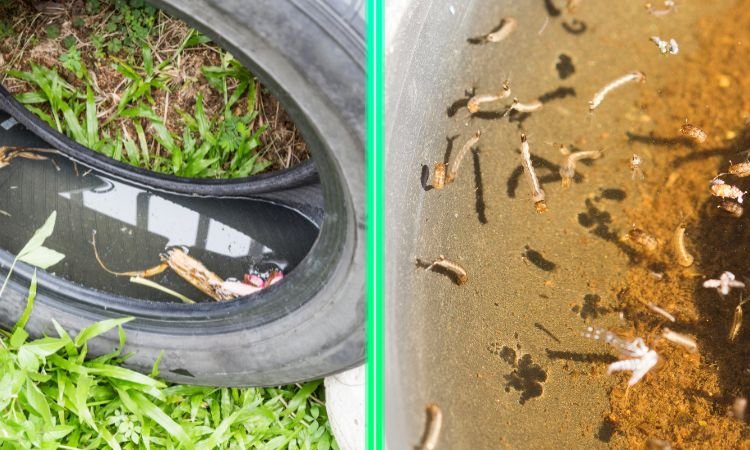5 Unexpected Mosquito Breeding Grounds in Your Backyard

Mosquitoes are a nuisance, plain and simple. It’s not that we hate them because of what they are, but we do hate them because of the tendency that they carry diseases that would surely affect our health. As they say, prevention is better than cure or solution and with that, the use of effective backyard mosquito control is the prevention that helps us identify and eliminate potential breeding grounds of these disease-carrying insects.
That’s why, in this article, we will explore the five potential mosquito breeding grounds that can be found in a typical backyard. As we identify these breeding grounds, we’ll also discuss how you can make these areas mosquito-free by giving you tips on how you can clean them properly.
KEY TAKEAWAYS
- To avoid mosquitoes creating breeding areas within your backyard, regularly clean and maintain gutters to free them from water accumulation.
- You may also want to inspect and drain any standing water from potted plants, containers, and pet bowls.
- When not in use, store children’s toys and outdoor play equipment indoors to eliminate their potential breeding sites.
- Check for and clear debris or water pockets on corrugated roofs and in tree holes or stumps.
1. Clogged Gutters
Out of many potential breeding sites for mosquitoes, clogged gutters are perhaps one of the most typical examples. If you come to think of it, leaves, twigs, and debris accumulate in gutters over time, and because of that, they can create pockets of stagnant water—which is an ideal environment for mosquito larvae to thrive.
Keep in mind that even a small amount of standing water is enough for female mosquitoes to lay their eggs. For roof gutters that are clogged, we normally tend not to notice it, provided that these are hard-to-reach areas. As a result, mosquito eggs are more likely to hatch at this place allowing them to become larvae and develop as full-grown mosquitoes—picturing yourself anytime soon dealing with a full-blown mosquito infestation.
In order to prevent this from happening, it’s important to regularly clean and maintain your gutters. You may want to install gutter guards or covers. This way, you can prevent debris buildup and water accumulation. But if you notice any water accumulation down the line, get a stick that’s enough for you to clear the blockage and let the gutters drain properly.
2. Potted Plants and Containers
Another potential breeding site that you may consider is potted plants and containers. What’s the problem with these pots and containers? The thing is they may seem harmless, but remember that they can quickly become mosquito breeding grounds if left unchecked over time.
Especially if it happens that you water your plants and like to store water in containers with no seal or cap in them, a small amount of standing water in these things can provide the perfect environment for mosquitoes to lay their eggs.
One way to prevent this from happening is you make a habit of regularly inspecting and emptying any containers that may collect water. If you have potted plants, try to make sure they have proper drainage holes and are placed on a level surface to prevent water accumulation. You may also want to consider using a saucer with a reservoir to collect excess water, which can be easily emptied.
3. Children’s Toys and Play Equipment
If ever you have kids that often play at your backyard, then you know how quickly their outdoor toys and play stuff can become a total mess. Well, that mess can also turn into a mosquito breeding zone if you’re not careful. Buckets, tarps, wading pools—anything left out can collect rain or sprinkler runoff.
Just like the previous ones, the fix is simple—stash away those toys and play equipment when not in use, either indoors or under a covered area. If ever something does manage to collect water, dump it out as soon as possible and let it fully dry. If that’s not the case, do regular check-ins, even when the toys are being used.
4. Corrugated Roof Materials
Speaking of check-ins, have you taken a look at your corrugated roofing lately? If not, it’s more likely that those ridges and valleys are perfect for trapping pockets of rainwater or condensation—a.k.a an open motel for mosquitoes to move on in.
It’s easy to overlook these tiny waterways, given that they are hard-to-reach areas just like your roof gutter. If neglected, they can turn into full-on mosquito breeding havens before you know it. Perhaps, once in a while or probably every quarter, make regular roof checks and clear out any debris or standing water you find. Or consider sealing or covering the corrugated materials to stop water collecting altogether.
5. Tree Holes and Stumps
Last but not least, don’t forget about those natural mosquito resorts right in your backyard—tree holes and old stumps! These areas tend to gather rainwater and groundwater runoff into stagnant little pools, which mosquitoes absolutely love for egg-laying.
The reason is that the moist and other organic environment related to it is like a mosquito maternity ward. Your best bet in shutting it down is filling in or draining those tree holes and stumps to get rid of any standing water. If that’s not possible, you may need to bring in some insecticides or mosquito dunks to kill off any larvae.
In a Nutshell
Mosquitoes can breed in some unexpected places around your backyard, from clogged gutters and potted plants to children’s toys and corrugated roofs. So stay vigilant and take proactive measures to eliminate standing water and potential breeding sites. That way, you can significantly reduce mosquito breeding areas in your backyard and enjoy your outdoor space without the constant buzzing and itching.














